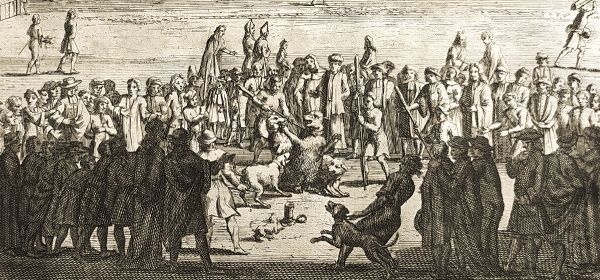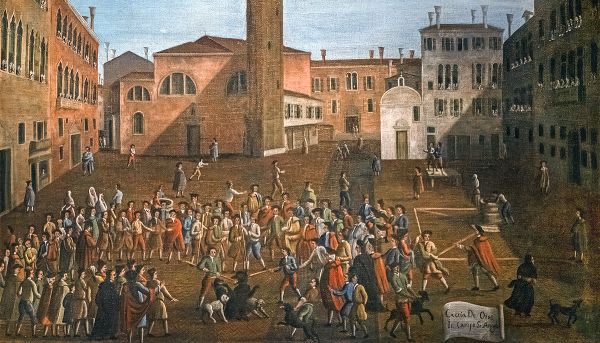

Same thing as the Cazza del Toro, but we have a bear here. The bull was more apt to defend itself, the bear a little less, but the "fun" was the same.
The managing of this entertainment wasn't of course always painless.
There is documentation about a domestic accident happenend to a certain Giorgio Emo, who was keeping in captivity a bear, and was killed by it, 35 deep wounds were found on his body.
The accident happened on May 20, 1607 - so well beyond Carnival time - the bear was kept for the future performances, I imagine.
And something a little unusual happened too in Santa Maria Formosa in 1688, when the Grand Duke of Tuscany Ferdinando de' Medici was visiting.
There were several bears, in this special occasion, and each bear was tied to a pole with quite a loose chain, so it could better defend itself against the dogs, thing that they did.
We can just imagine how bloody were the fights and how many dogs succumbed to the situation in spite of the cavacanis doing their best.
Public was delighted, though.


Cavacani literally means: "who is in charge of pulling out the dog from the bull or bear ear".
These dogs were as ferocius as possible - known as a special kind of "canis pugnax", a war dog which the Romans had been using for a long time for war and defense.
And they were exhibited with pride by their owners and would maim as much as possible the Bull or Bear, picking at their ears, which would be considered a trophy.
Quite a bloody pastime. For each bull or bear there was usually one dog at the time which would be set free so it would fight and pull the ears with its teeth. Unless the bull or bear was especially fiercely defending itself and then more dogs were added.
During the Bull Hunt or the Bear Hunt the idea was that the dog who had the most number of ears pulled out, was considered the winner of the "competition". The public of course was elated and participating and rooting for both parties.
Giovanni Grevembroch: "Cavacani" - pen, ink & watercolor (18th century) - Museo Correr, Venezia
